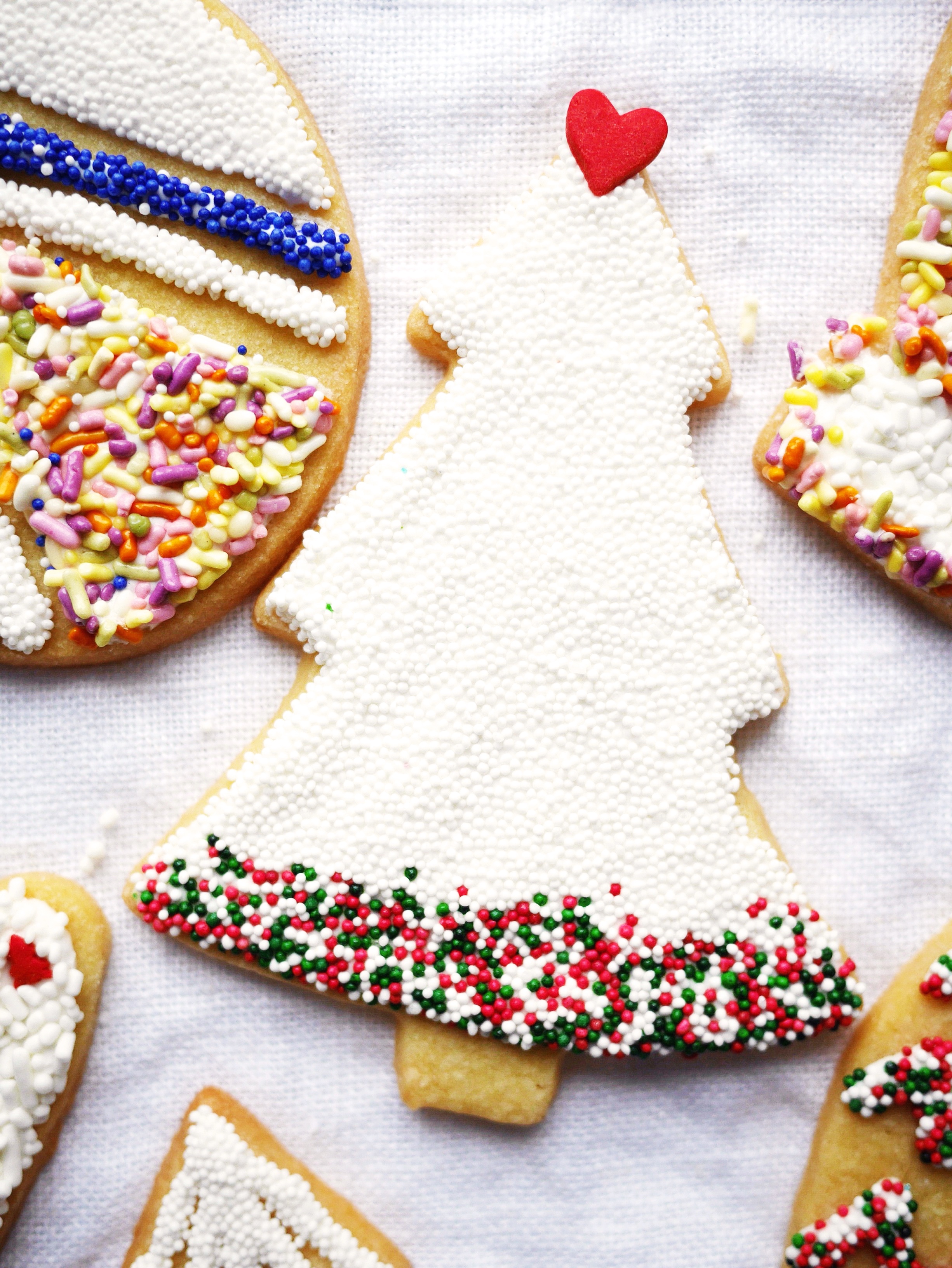Easy Holiday Sugar Cookie Recipe and Tips
Happy holidays, Mostess readers! I'm excited to share the results of my three-year obsession with perfecting the sugar cookie. It's a long post, because I wanted to share all my tips and techniques for success. If you are well-versed in Sugarcookiedom and "just want the recipe already!" then skip on down to the bottom of the post. For novices and baking nerds alike, read on.
How I became obsessed
Until three years ago, I had never decorated a sugar cookie. Maybe I'd adorned a gingersnap with a casual sprinkle somewhere along the line, but never with any purpose or focus. Then, at Real Simple, I was in charge of an enormous roundup of all the best sugar cookie decorating products. Everything from cutters to sprinkles to the best store-bought icing. As part of this project, which took five months and some 1,000 different bottles of sprinkles, I was lucky enough to hire Sweet Dani B, a master of cookie decorating, to decorate the trial cookies and our final shoot cookies. I spent two full days sitting by her side, learning the tricks of icing and applying sprinkles. (For more on decorating, check out my guide to cookie icing and your essential toolkit.)
After learning how fun and easy it was to transform this blank canvas, I was hooked. I made 150 cookies the first year to test out my skills, 300 last year, and this year, I don't even want to know how many I've gone through. All to get to the perfect cookie that's not too buttery (which causes the dough to spread and lose its shape,) easy to work with, but not too tough.
You may have noticed that I titled this post "easy" cookies. None of the steps are difficult, but they take some focus and planning. I promise the results are well worth it. Between cookie #1 and cookie #500 I learned a lot of lessons the hard way so you won't have to. Here are my tips for maximum cookie success!
The 5 Mostess Sugar Cookie Tips for Success
1. Chill out!
The techniques for making sugar cookies are simple, but I’m not going to lie to you and tell you that these aren’t time intensive. Success—meaning straight, clear edges and cookies that don’t morph from snowflake into flower-shaped blob in the oven—requires setting aside time to let the dough chill properly.
Chilling the dough does two things: it relaxes the gluten in the cookies, (more on this in my oatmeal-raisin cookie post,) but what is more important here is that it keeps the butter chilled. Warm butter will spread in the oven, making the cookies lose their shape, and they will be hard and not crispy, crunchy perfect.
2. Think ahead.
It may seem like common sense, but prepping your workspace and double checking that you have everything you need are two essential keys to successful cooking and baking, no matter the recipe.
When you are ready to roll out the dough and cut it into shapes, clear out enough space in your refrigerator to store the cookie sheets. I tend to leave this until the last moment and it causes a few knocked-over bottles, etc. Just before rolling, set aside a small bowl with all-purpose flour for dusting. Before cutting the dough out, make sure your cutters are nearby.
3. Be a clean freak.
Rolling dough on a dirty counter means your cookies might pick up specks of food, dust, or eau-de-garlic. Make sure your work surface is extra clean before rolling. I use a vinegar-water mixture to wipe it down just before I start.
4. Give cookies space.
Do not crowd the cookies on the sheet. Despite all the great work you've done to chill the dough adequately, each shape will expand. And, as the cookies bake, the butter releases steam. Too many cookies in the oven leads to a lot of steam, which you don't want. They will take longer to bake, and could end up too hard.
So, give the cookies space on the sheet, and if you can, bake only one sheet at a time, in the center of the oven. (Baking nerds: Check out this fun animation from TEDed about how cookie chemistry works.)
5. Keep an eye on it.
As my good friend Dawn always told me, "America underbakes it's pastry." For some reason this always made me laugh, thinking of the USA as a baker, but it is a truth worth remembering. Underbaked cookies won't be crispy and flaky, which is what you are going for here. Start checking your cookies at 14 minutes and remove them from the oven when just a bit of golden brown rings the edges of the shapes.
All right, enough already! Time to get baking. For icing recipes, tips, and some visual inspiration check out this other post.
Lemon and Vanilla Sugar Cookies by Lindsay Hunt
Makes about 36 cookies
Ingredients: 3 ¼ cups all-purpose flour, spooned and leveled (400g), plus additional for rolling 1 teaspoon kosher salt 1 teaspoon baking powder 2 ½ sticks (10 ounces) unsalted butter, at room temperature 1 ¼ cups granulated sugar 2 large eggs, plus one egg yolk, at room temperature 1 tablespoon pure vanilla extract 2 teaspoons finely grated lemon zest
Equipment: Two baking sheets (ideally without rims), parchment paper or nonstick cooking mats such as Silpat, a digital scale (if you have one), rolling pin, cookie cutters, and a stand mixer or another electric mixer
Make the dough: Whisk the flour, salt, and baking powder together in a medium bowl. Set aside.
Place the butter and sugars in the bowl of a stand mixer fitted with the paddle attachment (or use a hand mixer). Cream the butter and sugar on medium-high speed until light and fluffy, 3 to 4 minutes. Stop the mixer occasionally and scrape down the sides and paddle with a rubber spatula.
Add the eggs, vanilla, and lemon zest and mix on medium speed until well combined, about 1 minute. Add the flour mixture and mix on low speed until just combined, about 30 seconds.
Divide the dough in half and pat into two balls. (You may need to mush them together so they are even and there are no cracks.) Flatten and shape into two 1-inch thick discs and wrap tightly in plastic wrap.
Refrigerate the dough until firm, at least 2 hours and up to 3 days. At this point you can also freeze the dough for up to 1 month.
Roll and cut the dough:
About 45 minutes before you are ready to roll the dough out, remove the dough from the fridge. It has to soften enough to be easy to roll but not so much that it gets too soft and starts to stick to the countertop. Check the dough every 10 minutes or so, when it feels just pliable, it’s ready to roll. This can take anywhere from 20 to 45 minutes depending on the temperature of your kitchen and how long the dough was chilled.
Meanwhile, prepare the cookie sheets and set them next to your work space so they are ready. Working with one disc at a time, roll the dough out on a lightly floured surface until ¼-inch thick. Refrigerate the dough until firm, 20 to 30 minutes. (This is the step you can skip if you are pressed for time).
Return the chilled, rolled dough to the work surface and cut out shapes, placing the cutters as close together as possible. Use a flat spatula, not your fingers, to transfer the cut dough to the cookie sheet, leaving 2-inches between each shape.
Chill the cut dough for at least 20 to 30 minutes and up to 1 hour until very firm. You should be able to pick up a shape with your fingers without it bending at all.
30 minutes before baking, preheat the oven to 350º F with a rack in the middle of the oven. Bake one sheet at a time for 14 to 18 minutes, rotating the tray front to back halfway through. Pull the cookies out when they are golden throughout with golden brown edges.
Let the cookies cool on the sheet for 5 minutes, then transfer to a wire cooling rack to cool completely. If you let the cookies cool completely on the warm baking tray, they will steam and become slightly soggy.
Cookies will keep for up to 1 week in an airtight container.


